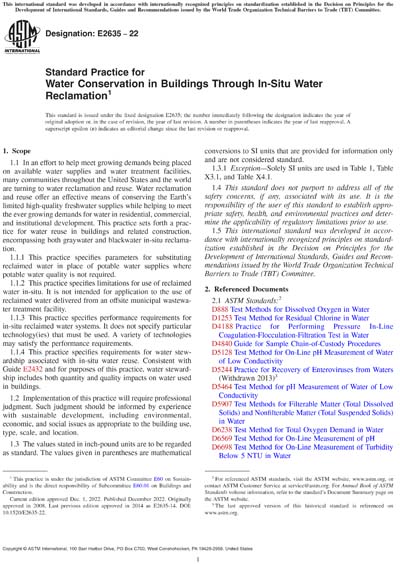Most recent
ASTM E2635-22
Standard Practice for Water Conservation in Buildings Through In-Situ Water Reclamation
1.1In an effort to help meet growing demands being placed on available water supplies and water treatment facilities, many communities throughout the United States and the world are turning to water reclamation and reuse. Water reclamation and reuse offer an effective means of conserving the Earth's limited high-quality freshwater supplies while helping to meet the ever growing demands for water in residential, commercial, and institutional development. This practice sets forth a practice for water reuse in buildings and related construction, encompassing both graywater and blackwater in-situ reclamation.
1.1.1This practice specifies parameters for substituting reclaimed water in place of potable water supplies where potable water quality is not required.
1.1.2This practice specifies limitations for use of reclaimed water in-situ. It is not intended for application to the use of reclaimed water delivered from an offsite municipal wastewater treatment facility.
1.1.3This practice specifies performance requirements for in-situ reclaimed water systems. It does not specify particular technology(ies) that must be used. A variety of technologies may satisfy the performance requirements.
1.1.4This practice specifies requirements for water stewardship associated with in-situ water reuse. Consistent with Guide E2432 and for purposes of this practice, water stewardship includes both quantity and quality impacts on water used in buildings.
1.2Implementation of this practice will require professional judgment. Such judgment should be informed by experience with sustainable development, including environmental, economic, and social issues as appropriate to the building use, type, scale, and location.
1.3The values stated in inch-pound units are to be regarded as standard. The values given in parentheses are mathematical conversions to SI units that are provided for information only and are not considered standard.
1.3.1Exception - Solely SI units are used in Table 1, Table X3.1, and Table X4.1.
1.4This standard does not purport to address all of the safety concerns, if any, associated with its use. It is the responsibility of the user of this standard to establish appropriate safety, health, and environmental practices and determine the applicability of regulatory limitations prior to use.
1.5This international standard was developed in accordance with internationally recognized principles on standardization established in the Decision on Principles for the Development of International Standards, Guides and Recommendations issued by the World Trade Organization Technical Barriers to Trade (TBT) Committee.
Content Provider
ASTM International [astm]






